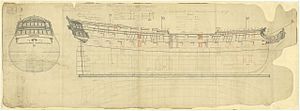HMS Defiance (1783) facts for kids

Defiance
|
|
Quick facts for kids History |
|
|---|---|
| Name | HMS Defiance |
| Ordered | 11 July 1780 |
| Builder | Randall, Rotherhithe |
| Laid down | April 1782 |
| Launched | 10 December 1783 |
| Honours and awards |
Participated in: |
| Fate | Broken up, 1817 |
| General characteristics | |
| Class and type | Elizabeth-class ship of the line |
| Tons burthen | 1685 bm |
| Length | 168 ft 6 in (51.36 m) (gundeck) |
| Beam | 46 ft 4 in (14.12 m) |
| Depth of hold | 19 ft 9 in (6.02 m) |
| Propulsion | Sails |
| Sail plan | Full-rigged ship |
| Armament |
|
HMS Defiance was a large 74-gun third rate ship of the line in the Royal Navy. This type of ship was a powerful warship, designed to fight in a line formation during battles. She was built by Randall and Co. in Rotherhithe, near the River Thames, and was launched on December 10, 1783.
Contents
Life at Sea: Challenges and Commanders
HMS Defiance was first put into service by Lieutenant M.T. Hewitt for Captain George Keppel. Life on a warship could be tough, and sometimes the crew had serious disagreements.
Crew Disagreements (Mutinies)
The crew of Defiance had disagreements three times. The first happened in October 1795, when Captain Sir George Home was in charge. The ship even needed soldiers to help keep order because it didn't have its full group of Marines.
In 1797, during the Spithead mutiny, the crew had another major disagreement. Captain William Bligh (famous for the mutiny on the Bounty) was ordered to bring 200 soldiers to the ship. Just the threat of these soldiers was enough to help end the disagreement.
A third disagreement happened in 1798 during a time of unrest called the United Irishmen rising. After this, some crew members faced very serious consequences.
Captain Thomas Revell Shivers took command in February 1797. Later, Captain Richard Retallick took over in December 1800. Defiance became the main ship, or flagship, for Rear Admiral Sir Thomas Graves.
Major Battles and Victories
HMS Defiance took part in several important naval battles, showing her strength and speed.
Battle of Copenhagen (1801)
On April 2, 1801, Defiance fought in the Battle of Copenhagen. She was the flagship for Rear Admiral Thomas Graves, with Captain Retallick leading the ship.
During the battle, Defiance was positioned near the powerful Crown battery, which had many heavy guns. Because other British ships couldn't get to their assigned spots, Defiance faced heavy fire from many directions. She suffered a lot of damage but kept fighting bravely.
Finisterre and Trafalgar (1805)
Defiance also joined the Battle of Cape Finisterre on July 22, 1805. Later that year, on October 21, she fought in the famous Battle of Trafalgar. At this time, Captain Philip Charles Durham was her commander. He even said that Defiance was the "fastest 74-gun ship in the British fleet."
At Trafalgar, Defiance captured two enemy ships: the Spanish ship San Juan Nepomuceno and the French ship Aigle. However, the French crew managed to take back the Aigle the next day before it was wrecked in a storm.
A Daring Boarding
Before a full group of British sailors boarded the Aigle, a very brave sailor named James "Jack" Spratt did something amazing. He dove into the sea from Defiance, swam to the Aigle with a cutlass in his teeth, and climbed in through a window.
He boarded the ship all by himself, facing hundreds of French sailors. He fought bravely, even though he was outnumbered. He was injured but saved when the rest of the boarding party from Defiance arrived.
During the Battle of Trafalgar, Defiance had 57 sailors killed and 153 wounded.
Later Service and Final Years
In 1809, Defiance took part in the Battle of Les Sables-d'Olonne. She also captured a French ship called Prudente in February 1809.
After a long and active career, HMS Defiance was used as a prison ship in Chatham starting in 1813. She was eventually taken apart in 1817.
Commanding Officers
Here are some of the captains who commanded HMS Defiance during her service:
- 1794 Captain George Keppel
- 1795 Captain Sir George Home, 7th Baronet
- 1796 Captain Theophilus Jones
- 1799 Captain T.R. Shivers
- 1801 Captain R. Retalick
- 1805 Captain Philip Charles Durham
- 1807 Captain Henry Hotham
- 1811 Captain Richard Raggett
Remembering Defiance: Trafalgar Wood Project
To remember the 33 Royal Navy ships that fought at the Battle of Trafalgar, a special forest was planted. In October and November 2005, a 10-acre wood was created in Dumfries, Dumfries and Galloway, Scotland. This wood honors HMS Defiance and her role in that historic battle.


